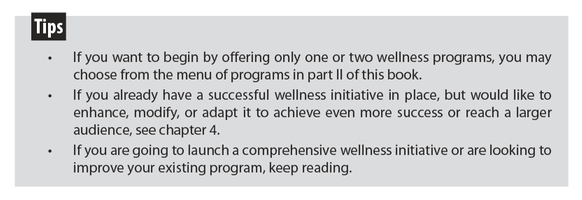First steps in developing successful wellness initiatives
This is an excerpt from Winning Health Promotion Strategies by Anne Marie Ludovici-Connolly.
Where to Begin
An organization was experiencing the worst financial climate in a decade. Employee morale was low, many jobs were being eliminated, and all department budgets were being cut. Leaders began investigating possible savings options within all divisions of the organization, including health care costs. To help accomplish this goal, they were contemplating the implementation of an employee wellness initiative. They were interested but not sure if they were fully committed to the idea. The director of human resources asked, “If we were to offer a wellness initiative, where would we begin?” Where would you begin? First, consider the following questions:
- What are your goals for wellness? If your goal is to introduce wellness to the organization, then you may want to begin by offering one or two wellness programs (see program examples in part II). If the goal is to make a significant impact on the culture and health of the organization, reduce health care costs and other costs such as workers' compensation or sick days, or achieve any other significant outcomes, begin planning for a comprehensive wellness initiative.
- What are your resources? If your resources and budget are slim, you may still offer a comprehensive wellness initiative, but you must be creative about using all of your current internal as well as external resources. Another option is to launch programs in phases over a period of time, or offer a few programs detailed in part II and wait until you can devote the funds and staff to make a bigger splash.
- How committed is the organization? If the organization and its leadership are fully committed to wellness, a comprehensive initiative may be successful. If the commitment is low, beginning with a few programs until you can garner full support may be the way to go.
- What is the climate of the organization at this time? Timing is everything. If it is a turbulent time within the organization, you may have a difficult time launching a comprehensive initiative. It really depends on many factors such as how the program is positioned and the commitment and goals of the organization.
There is no right or wrong direction in which to go based on how you answer these questions. You must use your best judgment and do what's best for your organization or group. The right answer for one organization may not be the right one for another. The wellness team or board of advisors should weigh all the internal and external variables when contemplating the timing of a program launch. Here are two strategies to choose from:
- Comprehensive wellness initiative: This chapter can assist those who would like to create a comprehensive wellness initiative. The evidence-based steps to building a successful initiative are easy to follow and highly effective.
- Traditional wellness programming: Another option for exploring wellness is to begin with a program or two. If you not quite ready or able to commit the time and resources to a full-scale initiative, begin with traditional programming to test the waters. Traditional programming may create some interest in wellness, reveal how open participants might be to a more comprehensive program, and provide time to get the support needed for a comprehensive initiative. Such programming also does not require intensive commitments such as employee health surveys. It is important to note that a return on investment (ROI) or organizational cost savings as a result of positive health behavior changes are less frequently observed with traditional programming.


SHOP

Get the latest insights with regular newsletters, plus periodic product information and special insider offers.
JOIN NOW


